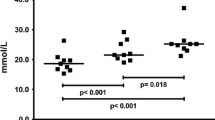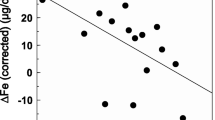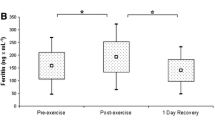Summary
Abnormal myoglobinemia (above 77 Μg/1) and free hemoglobin in plasma were found in 16 runners and in nine non runners immediately following distance running. The same abnormalities were found in six elite rowers following rowing. In parallel with the rise in myoglobin and free hemoglobin a rise was found in serum concentrations of cellular enzymes (LDH, CK, ASAT, alkaline phosphatase) and of various metabolites. We found no proteinuria nor casts in the urine. Non runners had a higher rise in serum myoglobin than runners. Competitive running caused a rise in the serum concentration of the heart specific fraction of creatine kinase in seven of the nine (healthy) elite runners. The abnormal findings are only explainable on the basis of leakage of proteins from muscle cells to the circulation in otherwise healthy, well trained persons. Myoglobinemia and a transient rhabdomyolysis is a common phenomenon in long distance running, but evidently also occurs in distance rowing. Three months of running training prevented most of the muscle damage from relaxed jogging in the nine previous non runners. Neither the observed myoglobinemia nor the hemoglobinemia resulted in any significant loss of iron in the urine.
Similar content being viewed by others
References
Ando T, Schimizu T, Koto T, Ohsawa M, Fukuyama Y (1978) Myoglobinemia in children with progressive muscular dystrophy. Clin Chim Acta 85: 17–22
åstrand P-O, Rodahl K (1977) Textbook of working physiology, 2 edn. McGraw Hill Book Co, New York, p 348
Booth F (1977) Effects of endurance exercise on cytochrome C turnover in skeletal muscle. Ann NY Acad Sci 301: 431–439
Buckle RM (1965) Exertional (march) hemoglobinurea. Reduction of hemolytic episodes by use of Sorbo-Rubber insoles in shoes. Lancet 1: 1136–1138
Carter P (1971) Spectrometric determination of serum iron at the submicrogram level with a new reagent (ferrozine). Anal Biochem 40: 450–458
Dancaster CP, Whereat SJ (1971) Renal function in marathon runners. SAfr Med J 45: 547–551
Fred HL, Natelson EA (1977) Grossly bloody urine of runners. South Med J 70: 1394–1396
Gerhardt W, WaldenstrØm J (1979) Creatinine kinase B-subunit activity in serum after immunoinhibition of M-subunit activity. Clin Chem 25: 1274–1280
Hansen K, NØrregaard, NØrgaard-Pedersen B (1979) Rapid and sensitive radioimmunoassays for human myoglobin. Scand J Clin Invest 39: 525–531
Harboe M (1959) A method for determination of hemoglobin in plasma by near-ultraviolet spectrophotometry. Scand J Clin Lab Invest 11: 66–70
Hische EAH, Helm J van der (1979) The significance of the serum myoglobin in neuromuscular diseases. J Neurol Sci 43: 243–251
Karlsson FA, Roxin L-E, Venge P, Wibell L (1978) Evaluation of urinary myoglobin assay test for myocardial infarction. Scand J Clin Lab Invest 38: 717–721
Kleiman Aa (1958) Hematuria in boxers. JAMA 168: 1633–1640
Küffer H, Richterich R (1973) Methodology of enzyme determination on the GSA II. Quad Sclavo Diagn 9: 61–69
Marmor A, Alpan G, Keidar S, Grenadier E, Palant A (1978) The MB isoenzyme of creatinine kinase as an indicator of severity of myocardial ischaemia. Lancet II: 812–814
Miyoshi K, Saito S, Kawai H, Kondo A, Iwasa M, Hayashi T, Yagita M (1978) Radioimmunoassay for human myoglobin: Method and results in patients with skeletal muscle or myocardial disorders. J Lab Clin Med 92: 341–352
Scandinavian Committee on Enzymes, Recommended method for determination of creatinine kinase in blood (1976) Scand J Clin Lab Invest 36: 711–723
Schiff H, MacSearraigh ETM, Kallmeyer JC (1978) Myoglobinuria, rhabdomyolysis and Marathon running. Q J Med 188: 463–472
Stahl CW (1957) March hemoglobinuria. Report of five cases in students at Ohio State University. JAMA 164: 1458–1460
Siegel AJ, Hennekens CH, Solomon HS, Boeckel B van (1979) Exercise-related hematuria. JAMA 241: 391–392
Standing S, Proce CP (1976) A kinetic method for the determination of haptoglobin as haemoglobin binding capacity. Clin Chim Acta 66: 393–403
Yasmineh WG, Ibrahim GA, Abbasnezhad M, Awad EA (1978) Isoenzyme distribution of creatinine kinase and lactate dehydrogenase in serum and skeletal muscle in Duchenn muscular dystrophy collagen disease, and other muscular disorders. Clin Chem 24: 1985–1989
Author information
Authors and Affiliations
Additional information
Supported by IdrÆttens Forskningsråd, Dansk IdrÆtsforbund
Rights and permissions
About this article
Cite this article
Hansen, K.N., Bjerre-Knudsen, J., Brodthagen, U. et al. Muscle cell leakage due to long distance training. Europ. J. Appl. Physiol. 48, 177–188 (1982). https://doi.org/10.1007/BF00422979
Accepted:
Issue Date:
DOI: https://doi.org/10.1007/BF00422979




